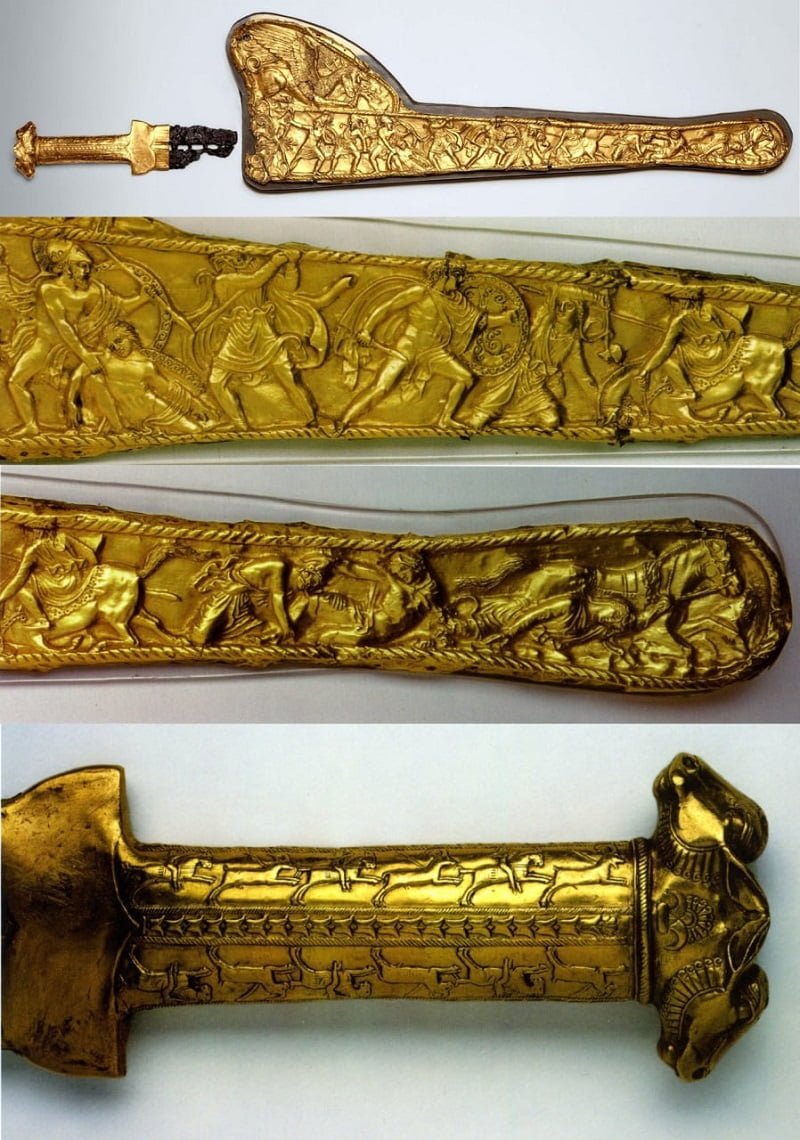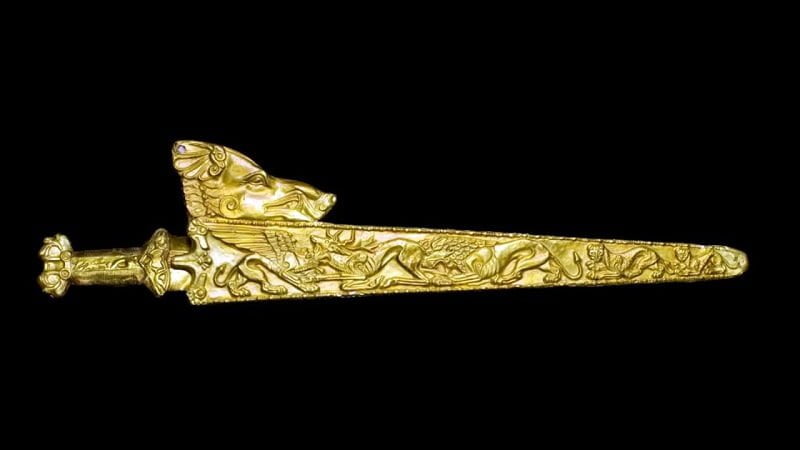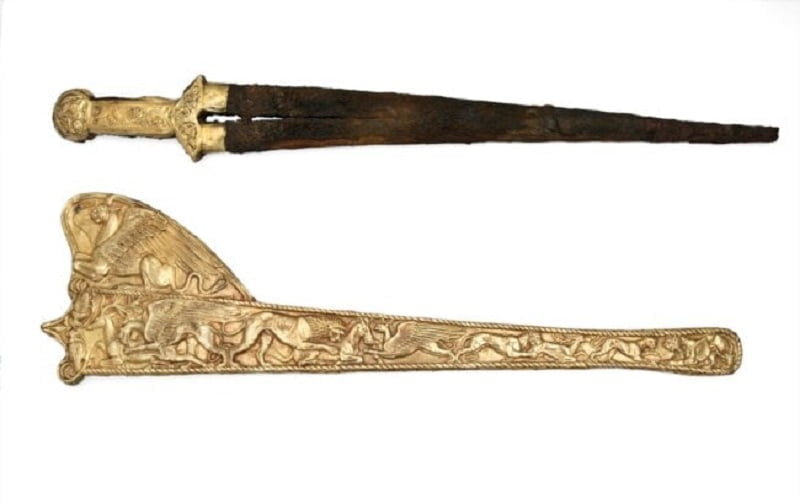Scythian Boar’s Head Sword and Scabbard, 4th Century BC
From a burial mound near the village of Velyka Bilozerka, Zaporizhia Region, Ukraine. It dates to the last third of the 4th Century BC.
With a projecting boar’s head, the gold scabbard also has images of a gryphon and a lion attacking a deer as two leopards watch.

Sheet-gold decoration for a sword scabbard

In the main frieze is a battle between Greeks and barbarians; at the left end stand two griffins. The irregular field above the frieze shows deer being killed, one by a lion, the other by a griffin.
The scabbard from which this gold decoration came would have been of another material, possibly bronze or iron. Such an elaborately embellished scabbard would have formed part of a ceremonial set of Scythian weapons typically including a sword, a bow, and a bow sheath. The Scythians were a nomadic people who lived in the Eurasian steppes during the first millennium B.C. Although the scabbard is of Scythian type, the decoration is Greek in style and undoubtedly of Greek workmanship. Similar sheet-metal goldwork from the royal cemetery at Vergina in northern Greece and from kurgans (burial mounds) of Scythian rulers in the North Pontic region (around the Black Sea) have been linked to the same workshop.

Large Pictures
The picture below is a composite of pictures found in the article of D. Topai “Scythian Akinakai Between
Carpathians and Dniester. The Structure of a Storm”.
It is quite helpful for dating the “stray finds” akinakai.

Chronology of Akinakai types
Frieze from Persepolis with guys wearing daggers that do not look like Scythian akinakai.
The inset from a different frieze shows a dagger that might be of the Scythian “bollocks” type.

What follows are some famous “gold” akinakai (the blade is made from iron, of course)

The famous “Scythian “Boars Head Sword and Scabbard”, from a burial mount (kurgan) near
the village of Velika Bilozerka, Ukaine. It dates to the last third of the 4th century BC, i.e. to about 330 BC.
Source: All oer the Net

A “gold akinaka” that the dutch have to returned to the Ukraine, from where it was stolen some time ago.
The age is a bit unclear, probably from roughly 400 BC. Note the very unusual forked blade.
Source: All over the Net

Here is the figure caption from the Hermitage:
“Scythian Culture; short sword – dagger (Akinaka) made of gold and iron. 7th century BC, Dnieper Area Hermitage Museum, St.Petersburg/ Russia
Source: Heremitage Internet pages
Following a few more “gold” akinakoi dorm the Hewremitgae in St. Petersburg:

Here is the figure caption from the Hermitage:
“Overlay fore a sword scabbard. Scythian culture, 350 – 325 BC. Place of finding: Dnieper region near Nikopol.
Source: Heremitage Internet pages

Here is the figure caption from the Hermitage:
Overlay for a sword scabbard, Created Scythian culture, 350 – 325 BC. Place of finding: Dnieper region near Nikopol.
Source: Heremitage Internet pages

Here is the figure caption from the Hermitage:
Hilt of Achaemenid sword
Overlay for a sword scabbard, Created Scythian culture, 5th – 4th century BC. Place of finding: Right bank of lower Dnieper region near Nikopol.
Source: Heremitage Internet pages

Also from the Hermitage but photographed by me in 2015. My Russian was not good enough to understand the text.
It is probably not much different from the one above.
Source: Photographed in the Hermitage in 2015
A “true” Akinaka found last year (2019) at “Mount Mamai” in the Ukraine. It dates from the 6th century BC
The detail shows the hilt after some cleaning.

Source: All over the News / Net
Here we have a Scythian chieftain, one supposes, sitting on top of his kurgan. He is definitely a male of the species and made sure that you notice that. Besides the real things he also sports a bollocks type of akinaka. There is a likeness.

Kurgan stelae of a Scythian (fondling his i-phone?) at Khortytsia, Ukraine
Insets show the bollocks parts with some contrast enhancement
Source: Wikipedia
Here is a somewhat unusual Cimmerian dagger, with possible connections to weapons in the far east around 900 BC or so.

Cimmerian Iron dagger and gold faced scabbard.
Found in a mound burial near the village of Belogradec, Varna district (VII c. BC). National Archaeological Museum – Sofia
Thracian sicas

Thracian sicas
Source: Found on Pininterest, original source not disclosed

Krummmesser, dakisch, 1. Jhdt. v. – 1. Jhdt. n. Chr.
Source: Hermann Historica auctions Fall 2022
Here is a large picture of some other daggers / swords displayed in the Hermitage, St. Petersburg.
They come from the Hermitage homepage where you can find these pictures (after some searching).
The major data given are included.
If these weapons come from Urartu may be a bit uncertain; the museum doesn’t mention it,

Swords / daggers from the Hermitage very much like the ones in the backbone part
Here is a contrast-enhanced X-ray picture of the bollock part of Scythian akinaka No. 4.
It does show some internal structure (marked by the arrows) but I won’t speculate what it might be besides
pointing out that the fained “lines” correspond to the continuation of the blade inside the guard bollocks.

X-ray of bollock parts of a Scythian akinaka showing some peculiarities (marked by the arrows)
Here are large pictures of the two akinakai discussed in the text:

Akinaka No. 6 “as received” and after cleaning / grinding / polishing
READ MORE:
Chinese Bronze Sword With Turquoise Studded, Gold Inlaid Rock Crystal Hilt. Warring States Period, 4th-2nd Century BC.
Sword from the Anglo-Saxon Sutton Hoo ship-burial, dates to approximately AD 620. Suffolk, England.
